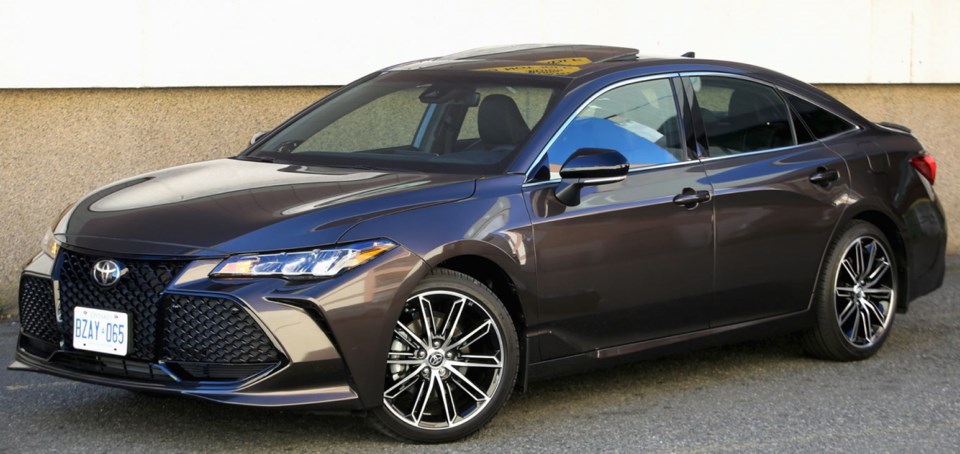The core of the 2019 Toyota Avalon is the concept of a near-luxury sedan from a non-luxury brand.
Toyota is a well-recognized brand that manufactures a wide variety of cars and trucks. Traditionally, a brand will try to capture a consumer at an early stage of their buying lives. It then will try to have different vehicles in its repertoire to appeal to that same consumer as they age.
The Avalon is meant to be at the apex of that journey, the top of the heap.
But that journey has been upended by Toyota itself, when it introduced its own luxury brand — Lexus.
Suddenly, instead of near-luxury, you could instead get the luxury branding for not much more.
So, is the 2019 Avalon still relevant, or has it been overtaken by the success of its luxury-branded sibling?
The Avalon is only offered in two trim levels. I drove a 2019 Toyota Avalon XSE, the base model, with a $42,790 list price.
In the Toyota universe, the Avalon is eclipsed by the more common Corolla and Camry by sheer numbers. The Camry, classified as a mid-sized sedan, is the closest in size to the Avalon, which falls under the full-size designation.
The 2019 is a stitch longer and wider than last year’s model. Its wheelbase has also seen a 50-millimetre increase. By comparison, the Avalon’s wheelbase is now 95 millimetres longer than the Nissan Maxima, a close competitor.
Those extra millimetres can best be experienced in the back seats, where legroom can be described as generous.
If the interior is generous, the exterior can best be described as gorgeous.
It has taken a page from its luxury sibling, with a front grille that projects an upscale, aggressive visage. The whole front of the car looks like an intake grille, with not even a token bumper to mar the illusion.
Overall, the creases, bends and character lines work, creating a four-door sedan that projects an up-market feel while still proudly grounded on its dependable roots.
There is only one powertrain available, a naturally aspirated 3.5-litre V-6, mated with an eight-speed automatic transmission driving the front wheels.
While the new V-6 shares its displacement with last year’s engine, it is more powerful — at 301 horsepower, it is up 33 ponies from before. The new engine, which features elements of both direct and port injection, is more efficient, delivering better fuel economy than last year (as well as the Maxima). A bonus is that the Avalon runs happily on regular-grade fuel, not premium, as is recommended for the Maxima.
The transmission has two more gears compared with last year, with the top two serving as overdrive. Much as I admire the Nissan’s CVT, as an enthusiast I still prefer the feel of a smooth-shifting, conventionally geared automatic.
The Avalon boasts a Sport mode and steering-wheel paddle shifters, but realistically, the typical buyer will probably just let the car do the shifting itself.
The XSE features a more aggressive sport-tuned suspension compared with the upscale Limited model, but the Avalon’s character and ride are more geared for comfort, not performance. This is a car meant for the highway, not the short track.
One desirable model that Canadians won’t be able to order is a hybrid gasoline-electric version, which is available south of the border.
The interior of the Avalon has also benefited from a major overhaul, with more upscale elements, pleasing lines and subdued materials.
But the biggest change is Entune, Toyota’s smartphone-based infotainment system. The system offers an intuitive interface and on-board connectivity for cloud-based features. It also allows you to monitor your car remotely, alert you if your car has been driven at certain times, past a chosen speed and outside of a given area (these last features might give your teenage drivers a cold chill down their spines).
This year it also integrated Apple CarPlay, but Android Auto is still nowhere to be found.
The system consists of a seven-inch touchscreen with buttons and two knobs — a larger one for volume/power and a smaller one for tuning.
You get cloud-based streaming music and the Scout GPS Link, which offers turn-by-turn navigation. Be aware that Scout requires a subscription after a three-year free trial.
Personally, I still prefer a GPS-based navigation system, which is free and doesn’t require using data from your phone plan.
The 2019 Toyota Avalon is about $2,200 less than the Lexus ES 350 and $1,900 more than the top-of-the-line Toyota Camry XLE V6 (which shares the same engine, but is slightly smaller).
Looking at the numbers, it’s probably no surprise to see that although the Avalon continues to be the pinnacle of the Toyota line, it is but a stepping-stone for the next level, should your aspirations take you into the luxury realm.
The spec sheet
Type: Full-sized four-door sedan, front engine, front-wheel drive
Engine: Naturally-aspirated 3.5-litre V-6, 301 hp at 6.600 r.p.m., 267 lb.-ft. of torque at 4,700
Transmission: Eight-speed automatic
Dimensions (mm): Length, 4,976; width, 1,850; height, 1,435; wheelbase, 2,870
Curb weight (kg): 1,650
Price (base/as tested): $42,790/ $44,635 (includes $1,745 freight and PDI and $100 AC tax)
Options: Nil
Tires: 235/45 R 18 tires on alloy wheels
Fuel type: Regular
Fuel economy (L/100km): 10.9 city/ 7.6 highway
Warranty: Three years/60,000 km new car, five years/100,000 km powertrain and roadside assistance



